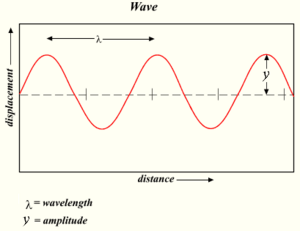Amplitude facts for kids
The amplitude of a wave tells us how big its oscillation (or wiggle) is. Think of it as how high a water wave gets, or how loud a sound is.
Amplitude is always measured as a positive number, like 5 or 10. It is never a negative value. This is because amplitude measures a distance or a strength, and distance cannot be negative.
The distance from the very top of a wave to its very bottom is called the peak-to-peak amplitude. It shows the total swing of the wave from its highest point to its lowest point. Amplitude also describes the maximum distance a wave moves from its resting or "equilibrium" position.
Contents
What Are the Units of Amplitude?
The units used to measure amplitude depend on the type of wave you are looking at. The unit will always match what the wave is actually doing.
Water and String Waves
For waves on a string (like a guitar string) or in a medium like water, the amplitude is a displacement. This means it's measured in units of length, such as meters or centimeters. For example, a water wave might have an amplitude of 0.5 meters, meaning it rises 0.5 meters above its calm level.
Sound Waves
The amplitude of sound waves is usually related to the air pressure changes they create. A larger amplitude means a louder sound. Sometimes, it can also describe how much the air particles move. While loudness is connected to amplitude, we can often tell how loud a sound is even if its amplitude changes slightly.
Light Waves
For electromagnetic radiation, like light, the amplitude of a photon relates to how much the electric field of the wave changes. This change in the electric field is what we perceive as the brightness or intensity of light.
Radio signals are a type of electromagnetic radiation. Their amplitude can be changed (this is called amplitude modulation) or their frequency can be changed (this is called frequency modulation) to carry information.
Related Pages
- Waves and their properties:
- Amplitude modulation
- Vibration control
- Vibration isolation
See also
 In Spanish: Amplitud (física) para niños
In Spanish: Amplitud (física) para niños



